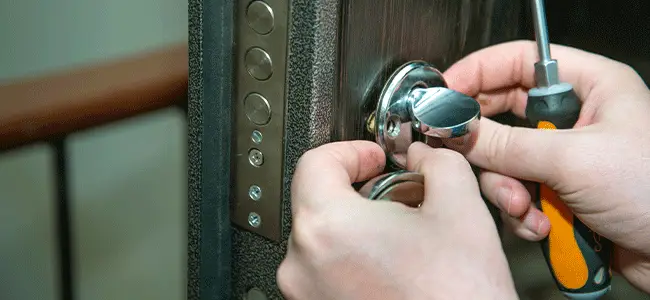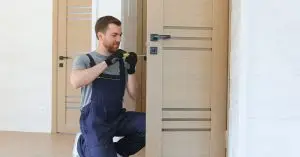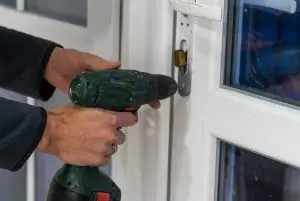Fire doors are one of the most important safety features in any commercial building. They protect people and property by containing smoke and fire, giving everyone more time to escape and firefighters more time to respond. Yet, their effectiveness depends on one critical factor: proper maintenance of the locks and hardware. When fire door locks fail, the entire system fails.
As locksmiths, we often find that even well-managed buildings overlook fire door maintenance until a safety audit or emergency occurs. Below, we’ll explain what it means to maintain fire door locks correctly, why it matters for compliance, and how you can build a simple, reliable maintenance routine.
Understanding What Makes Fire Door Locks Different
A fire door is not a standard door. It is part of a tested and certified system that includes the door, frame, hinges, seals, and locks. Every piece of hardware must meet specific fire ratings to ensure that, during a fire, the door remains closed and resists heat long enough to contain flames.
Fire door locks are designed to stay secure even under high temperatures. They must allow quick egress from the inside while maintaining the integrity of the door during fire exposure. If a lock is replaced or modified with a non-rated part, the certification is void, which means the door may not perform when it matters most.
Why Regular Maintenance is Essential
Regular maintenance is not only about safety; it is also a legal requirement. Fire doors and their locks fall under both national and provincial building and fire codes. Failing to maintain them can result in fines or insurance issues if damage or injury occurs.
Over time, locks experience wear. Springs weaken, latches misalign, and door closers lose tension. Dust, moisture, and temperature changes can all cause mechanical issues. Routine inspection prevents these small problems from turning into dangerous failures. It also helps prove due diligence in compliance audits.
Building a Simple Maintenance Schedule
We recommend setting a consistent inspection schedule that aligns with your building’s fire safety plan. For most facilities, this means checking fire door locks quarterly, with a more thorough annual inspection.
During quarterly checks, focus on visible and functional issues:
- Test the latch to ensure it fully engages the strike when the door closes.
- Confirm that the door self-closes properly without sticking or slamming.
- Check that no parts are missing or loose.
- Verify that signage remains visible and legible.
An annual inspection should include deeper tests by qualified technicians. For example, a professional locksmith in Calgary can confirm whether each lock remains compliant with fire door standards and whether any parts need replacement.
Key Components to Inspect
Each component of a fire door lock system plays a role in maintaining fire resistance and egress function. Pay attention to:
1. Latch and strike alignment
If the latch does not fit perfectly into the strike plate, the door cannot perform as a barrier. Misalignment can result from door frame warping, hinge wear, or building movement.
2. Hinges and closers
A heavy fire door depends on properly adjusted hinges and closers. Even a slightly loose hinge can prevent the door from closing completely, defeating its purpose.
3. Lock cylinder and key operation
Keys should turn smoothly. If resistance is felt, do not force it. Lubricate with graphite or a dry-based lubricant designed for locks. Avoid oil-based products that collect dust.
4. Intumescent seals
These seals expand under heat to prevent smoke from passing through gaps. If they are cracked, missing, or painted over, replace them immediately.
5. Panic hardware or push bars
Ensure that panic bars or emergency exit hardware release easily and fully retract after use. If they feel stiff or delayed, they need immediate adjustment.
The Role of Documentation
Maintenance without documentation is hard to verify during an inspection. Every time a door or lock is tested, record the date, the person who inspected it, and any findings or repairs. Keep records accessible for fire marshals and safety auditors.
Documentation also helps identify recurring issues. For example, if the same door repeatedly needs latch adjustments, there may be a structural problem with the frame or hinges. This kind of insight saves money and prevents failures over time.
When to Replace Fire Door Locks
Even well-maintained locks have a lifespan. Manufacturers often recommend replacement every five to seven years, depending on use and environment. However, some conditions require earlier replacement:
- Corrosion or rust on internal components
- Visible damage after a fire or impact
- Non-rated parts installed during past repairs
- Keys that frequently jam or stick
- Doors that fail to self-latch during closure tests
Replacing locks should always involve components rated for the specific fire door model. A certified commercial locksmith in Calgary can help ensure that every part installed meets fire and accessibility codes.
Cleaning and Lubrication Tips
Keeping fire door locks clean is a simple yet often neglected task. Wipe hardware with a dry cloth to remove dust and debris. If deeper cleaning is needed, use a mild detergent and water but never soak the mechanism.
For lubrication, avoid household oils. Instead, use graphite powder or a specialized lock lubricant. These products prevent buildup that could interfere with the latch mechanism. Always test the lock afterward to confirm smooth operation.
Common Compliance Mistakes
Many building managers unintentionally violate fire door standards because they treat these doors like regular entry doors. Common issues include:
- Installing door stops or wedges to hold fire doors open.
- Replacing rated locks with cheaper, non-certified hardware.
- Painting over labels or seals that identify fire rating.
- Ignoring gaps or damaged frames.
- Using adhesive signage or weatherstripping not approved for fire doors.
Every one of these mistakes can lead to serious consequences. Fire doors must close automatically, remain unobstructed, and maintain their rated condition at all times.
Coordinating Maintenance with Building Staff
If your building has multiple fire doors, it helps to train maintenance personnel to perform preliminary inspections. They can report early signs of wear, missing screws, or difficulty closing.
However, repairs and certifications should always be handled by professionals familiar with fire-rated hardware. Scheduling a regular service visit from a local locksmith ensures consistency, code compliance, and accountability.
Integrating Fire Door Maintenance into Safety Audits
Fire doors are part of the larger fire safety system that includes alarms, extinguishers, sprinklers, and evacuation plans. When audits are performed, each component must show evidence of maintenance.
Integrate fire door checks into your existing safety audit checklist. Doing this keeps records aligned and ensures that lock inspections are never missed. It also gives you a full picture of your building’s fire readiness.
The Importance of Staff Awareness
Employees and tenants often interfere with fire doors without realizing the risks. They might prop them open for convenience or tape over latches. Education is key.
We recommend posting reminders near doors explaining their purpose and the importance of keeping them closed. During safety briefings, mention fire door function and why no one should modify or block them. A simple conversation can prevent a costly safety violation.
Long-Term Benefits of Routine Maintenance
Consistent fire door lock maintenance has long-term rewards. It prevents emergency downtime, reduces repair costs, and ensures compliance during inspections. More importantly, it protects lives.
A properly maintained door can contain a fire for up to 60 minutes, giving everyone critical time to evacuate. Without it, smoke and flames spread within minutes. The difference often comes down to whether the lock and latch function as intended.
When to Involve a Professional
While building staff can perform visual checks, only trained technicians can test and adjust locks to fire door standards. This includes verifying latch strength, measuring closing speed, and replacing rated hardware when needed.
If you notice any irregularities, such as misalignment, difficulty closing, or signs of tampering—it’s best to call a professional immediately. Consistent inspections by a certified locksmith help prevent compliance issues and ensure every door meets safety codes.
For service or consultation, you can always contact us directly to schedule an inspection or ask about your current fire door system.
FAQ
1. How often should fire door locks be inspected?
At least every three months for high-traffic areas and annually for all others. Frequent checks catch wear early and help maintain compliance.
2. Can I use regular locks on fire doors?
No. Only fire-rated locks that match the door’s certification are acceptable. Using non-rated parts voids compliance and endangers safety.
3. What should I do if a fire door doesn’t close properly?
Report it immediately. Do not attempt temporary fixes like doorstops or wedges. The problem likely involves alignment or hardware failure that needs professional repair.
4. Is lubricating the lock enough for maintenance?
Lubrication helps but is not sufficient on its own. Regular inspection and adjustment of hinges, closers, and latches are equally important.
5. Do fire doors need to be tested after repairs?
Yes. Any replaced or repaired component must be tested to confirm that the door still meets its fire rating and operational standards.





